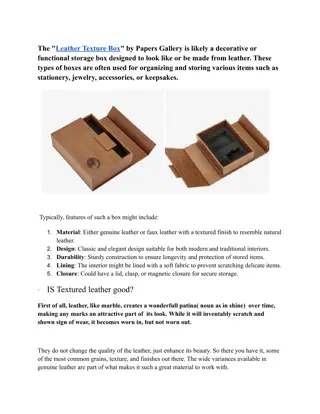Understanding Texture in Design: Types and Importance
Texture plays a crucial role in design by adding visual interest, contrast, and balance to compositions. There are two main types of texture: Image texture, which includes environmental, biological, and man-made textures, and Pattern texture, which is structured and often used for decoration or branding purposes.
Download Presentation

Please find below an Image/Link to download the presentation.
The content on the website is provided AS IS for your information and personal use only. It may not be sold, licensed, or shared on other websites without obtaining consent from the author. Download presentation by click this link. If you encounter any issues during the download, it is possible that the publisher has removed the file from their server.
E N D
Presentation Transcript
TEXTURE What is texture? Importance of texture. Types of texture.
What is texture? Texture is the way the surface of an object feels or how it is perceived to feel.
Importance of texture It create visual interest or focal point in a composition It creates contrast It helps to visually balance a design composition
Types of Texture There are two types of texture: Image texture and Pattern texture Image texture or real texture: is a combination of organic or geometric shapes and colour. It appeals to smell and touch and the eye is drawn to it. It can be environmental, biological or man- made. It can be simple or complex but usually appear random to create a particular look or feel.
Types of texture Image texture: environmental textures can be wood, grain, sand, water to the stars in the sky.
Types of texture Biological texture can be skin, fur, feathers and animal prints.
Types of texture Man-made textures can be paintings, illustrations, dies, cloths, papers, typography, photographic effects, etc.
Environmental and Biological textures
Pattern texture Pattern texture or implied texture: this is also generated from organic or geometric shapes and colour but is mostly manufactured. Pattern texture unlike image texture is more structured. Repeating a formation of shape and colour would result in a pattern texture. Pattern is more about the visual due to the repetition of shapes as a result it works well and can be used as decoration.
Pattern texture An example of the use of pattern texture is in branding. A brand can use this visual design element to help you remember them. Another example if gift wrapping paper. Have you even wondered why gift wrapping paper has patterns than a single image? Why people spend so much money on it? The repetition of bright colours and images excite the visual senses.























